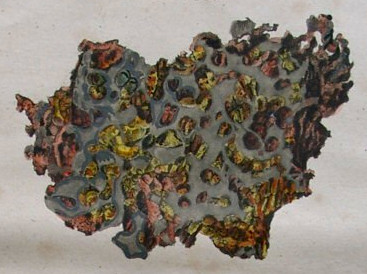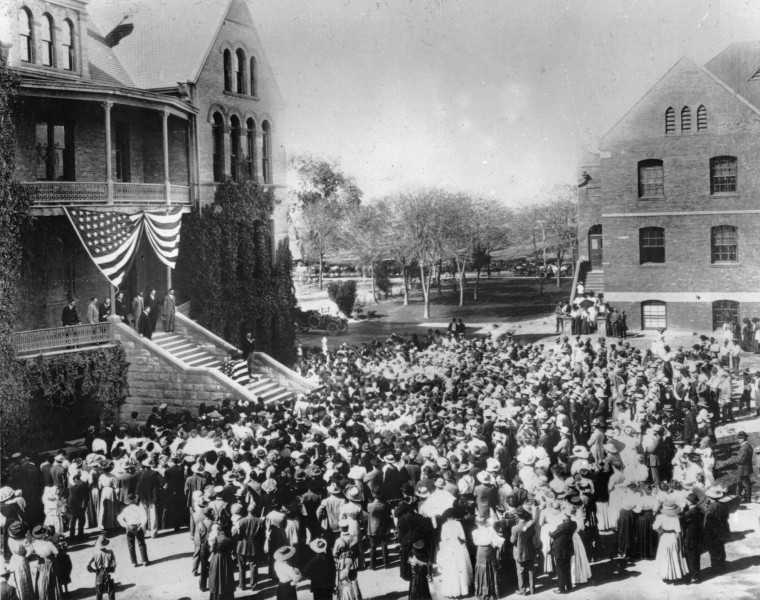|
Huckitta
Huckitta is a pallasite meteorite recovered in 1937 from Huckitta Cattle Station in the Northern Territory of Australia. History In 1924 a meteoritic mass of was found by Herbert Basedow on Burt Plain (23°33'S, 133°52'E), about north of Alice Springs. This mass was called ''Alice Springs''. In July 1937, the main mass of was recovered by Cecil Madigan at Huckitta (22°22'S, 135°46'E). Over of iron shale was also found. The ''Alice Springs'' meteorite was then paired with the main mass and considered a transported fragment. Today the location of the site where the main mass was found is on Arapunya Cattle Station, which had been part of Huckitta Cattle Station but was excised from it after the meteorite had been recovered. Composition and classification It is a pallasite related to Main Group of pallasites. This pallasite is severely weathered: almost all of the metal is highly oxidized and transformed mainly into maghemite and goethite, and the olivine crystals are o ... [...More Info...] [...Related Items...] OR: [Wikipedia] [Google] [Baidu] |
Cecil Madigan
Cecil Thomas Madigan (15 October 1889 – 14 January 1947) was an Australian explorer and geologist, academic, aerial surveyor, meteorologist, author and officer of the British army. He was born in Renmark, South Australia. His family had associations with William Benjamin Chaffey. Biography Born to contractor and fruitgrower Thomas Madigan and Mary Dixie (née Finey) a teacher, Cecil Madigan was the oldest of two sons and two daughters. He was raised by his mother as his father had died in the Kalgoorlie, Western Australian Goldfields. He attended Prince Alfred College in Adelaide, the University of Adelaide, and the South Australian School of Mining and Industry. He won a Rhodes scholarship in 1911 to study geology at Magdalen College, Oxford, but deferred the appointment as he was invited by Sir Douglas Mawson to go as meteorologist on the Australasian Antarctic Expedition. In December 1911 the party left Hobart on board the SY Aurora. In January 1912 they reached Commonweal ... [...More Info...] [...Related Items...] OR: [Wikipedia] [Google] [Baidu] |
Pallasite
The pallasites are a class of stony–iron meteorite. Structure and composition It consists of centimetre-sized olivine crystals of peridot quality in an iron-nickel matrix. Coarser metal areas develop Widmanstätten patterns upon etching. Minor constituents are schreibersite, troilite, chromite, pyroxenes, and phosphates (whitlockite, stanfieldite, farringtonite, and merrillite). Classification and subgroups Using the oxygen isotopic composition, meteoric iron composition and silicate composition pallasites are divided into 4 subgroups:O. Richard Norton. ''The Cambridge encyclopedia of meteorites''. Cambridge, Cambridge University Press, 2002. . * Main group pallasites (PMG): Almost all pallasites * Eagle Station group (PES): 5 specimens known. They are related to IIF irons. * Pyroxene Pallasite grouplet (PPX): Counts only Vermillion and Yamato 8451. They take their name from the high orthopyroxene content (about 5%). Metal matrix shows a fine octahedrite Widmanstätten pat ... [...More Info...] [...Related Items...] OR: [Wikipedia] [Google] [Baidu] |
Pallasite
The pallasites are a class of stony–iron meteorite. Structure and composition It consists of centimetre-sized olivine crystals of peridot quality in an iron-nickel matrix. Coarser metal areas develop Widmanstätten patterns upon etching. Minor constituents are schreibersite, troilite, chromite, pyroxenes, and phosphates (whitlockite, stanfieldite, farringtonite, and merrillite). Classification and subgroups Using the oxygen isotopic composition, meteoric iron composition and silicate composition pallasites are divided into 4 subgroups:O. Richard Norton. ''The Cambridge encyclopedia of meteorites''. Cambridge, Cambridge University Press, 2002. . * Main group pallasites (PMG): Almost all pallasites * Eagle Station group (PES): 5 specimens known. They are related to IIF irons. * Pyroxene Pallasite grouplet (PPX): Counts only Vermillion and Yamato 8451. They take their name from the high orthopyroxene content (about 5%). Metal matrix shows a fine octahedrite Widmanstätten pat ... [...More Info...] [...Related Items...] OR: [Wikipedia] [Google] [Baidu] |
Maghemite
Maghemite (Fe2O3, γ-Fe2O3) is a member of the family of iron oxides. It has the same spinel ferrite structure as magnetite and is also ferrimagnetic. It is sometimes spelled as "maghaemite". ''Maghemite'' can be considered as an Fe(II)-deficient magnetite with formula \left(\ce\right)_A\left ce\rightB\ce where \square represents a vacancy, A indicates tetrahedral and B octahedral positioning. Occurrence Maghemite forms by weathering or low-temperature oxidation of spinels containing iron(II) such as magnetite or titanomagnetite. Maghemite can also form through dehydration and transformation of certain iron oxyhydroxide minerals, such as lepidocrocite and ferrihydrite. It occurs as widespread brown or yellow pigment in terrestrial sediments and soils. It is associated with magnetite, ilmenite, anatase, pyrite, marcasite, lepidocrocite and goethite. It is known to also form in areas that have been subjected to bushfires (particularly in the Leonora area of Western Australia) m ... [...More Info...] [...Related Items...] OR: [Wikipedia] [Google] [Baidu] |
Goethite
Goethite (, ) is a mineral of the diaspore group, consisting of iron(III) oxide-hydroxide, specifically the "α" polymorph. It is found in soil and other low-temperature environments such as sediment. Goethite has been well known since ancient times for its use as a pigment (brown ochre). Evidence has been found of its use in paint pigment samples taken from the caves of Lascaux in France. It was first described in 1806 based on samples found in the Hollertszug Mine in Herdorf, Germany. The mineral was named after the German polymath and poet Johann Wolfgang von Goethe (1749–1832). Composition Goethite is an iron oxyhydroxide containing ferric iron. It is the main component of rust and bog iron ore. Goethite's hardness ranges from 5.0 to 5.5 on the Mohs Scale, and its specific gravity varies from 3.3 to 4.3. The mineral forms prismatic needle-like crystals ("needle ironstone") but is more typically massive. Feroxyhyte and lepidocrocite are both polymorphs of the iron oxy ... [...More Info...] [...Related Items...] OR: [Wikipedia] [Google] [Baidu] |
Olivine
The mineral olivine () is a magnesium iron silicate with the chemical formula . It is a type of nesosilicate or orthosilicate. The primary component of the Earth's upper mantle, it is a common mineral in Earth's subsurface, but weathers quickly on the surface. For this reason, olivine has been proposed as a good candidate for accelerated weathering to sequester carbon dioxide from the Earth's oceans and atmosphere, as part of climate change mitigation. Olivine also has many other historical uses, such as the gemstone peridot (or chrysolite), as well as industrial applications like metalworking processes. The ratio of magnesium to iron varies between the two endmembers of the solid solution series: forsterite (Mg-endmember: ) and fayalite (Fe-endmember: ). Compositions of olivine are commonly expressed as molar percentages of forsterite (Fo) and fayalite (Fa) (''e.g.'', Fo70Fa30). Forsterite's melting temperature is unusually high at atmospheric pressure, almost , while ... [...More Info...] [...Related Items...] OR: [Wikipedia] [Google] [Baidu] |
South Australian Museum
The South Australian Museum is a natural history museum and research institution in Adelaide, South Australia, founded in 1856 and owned by the Government of South Australia. It occupies a complex of buildings on North Terrace in the cultural precinct of the Adelaide Parklands. Plans are under way to move much of its Australian Aboriginal cultural collection (the largest in the world), into a new National Gallery for Aboriginal Art and Cultures. History 19th century There had been earlier attempts at setting up mechanics' institutes in the colony, but they struggled to find buildings which could hold their library collections and provide spaces for lectures and entertainments. In 1856, the colonial government promised support for all institutes, in the form of provision the first government-funded purpose-built cultural institution building. The South Australian Institute, incorporating a public library and a museum, was established in 1861 in the rented premises of the ... [...More Info...] [...Related Items...] OR: [Wikipedia] [Google] [Baidu] |
Adelaide
Adelaide ( ) is the capital city of South Australia, the state's largest city and the fifth-most populous city in Australia. "Adelaide" may refer to either Greater Adelaide (including the Adelaide Hills) or the Adelaide city centre. The demonym ''Adelaidean'' is used to denote the city and the residents of Adelaide. The Traditional Owners of the Adelaide region are the Kaurna people. The area of the city centre and surrounding parklands is called ' in the Kaurna language. Adelaide is situated on the Adelaide Plains north of the Fleurieu Peninsula, between the Gulf St Vincent in the west and the Mount Lofty Ranges in the east. Its metropolitan area extends from the coast to the foothills of the Mount Lofty Ranges, and stretches from Gawler in the north to Sellicks Beach in the south. Named in honour of Queen Adelaide, the city was founded in 1836 as the planned capital for the only freely-settled British province in Australia. Colonel William Light, one of Adelaide's foun ... [...More Info...] [...Related Items...] OR: [Wikipedia] [Google] [Baidu] |
Monnig
Oscar E. Monnig (September 4, 1902 – May 4, 1999) was an American amateur astronomer, acknowledged for his contributions to meteoritics. Private life Monnig was born in Fort Worth, Texas, the United States. In 1925 he received a law degree from the University of Texas. He worked for the family dry goods business and was its president from 1974 to 1981, when it was sold. In 1941 he married Juanita Mickle, who died in 1996. They had no children. Monnig died in the city where he was born on May 4, 1999. Astronomy In the 1920s Monnig started to be interested in astronomy. He founded the Texas Observers astronomy club and between 1931 and 1947 he published a monthly newsletter – the ''Texas Observers Bulletin'' – writing especially about issues of amateur astronomers' interest, such as variable stars, meteors, comets, and the planets. In the late-1920s, Monnig developed an interest in meteorites and their contribution to astronomers' studies on the origins of the Sola ... [...More Info...] [...Related Items...] OR: [Wikipedia] [Google] [Baidu] |
Texas
Texas (, ; Spanish language, Spanish: ''Texas'', ''Tejas'') is a state in the South Central United States, South Central region of the United States. At 268,596 square miles (695,662 km2), and with more than 29.1 million residents in 2020, it is the second-largest U.S. state by both List of U.S. states and territories by area, area (after Alaska) and List of U.S. states and territories by population, population (after California). Texas shares borders with the states of Louisiana to the east, Arkansas to the northeast, Oklahoma to the north, New Mexico to the west, and the Mexico, Mexican States of Mexico, states of Chihuahua (state), Chihuahua, Coahuila, Nuevo León, and Tamaulipas to the south and southwest; and has a coastline with the Gulf of Mexico to the southeast. Houston is the List of cities in Texas by population, most populous city in Texas and the List of United States cities by population, fourth-largest in the U.S., while San Antonio is the second most pop ... [...More Info...] [...Related Items...] OR: [Wikipedia] [Google] [Baidu] |
Arizona State University
Arizona State University (Arizona State or ASU) is a public research university in the Phoenix metropolitan area. Founded in 1885 by the 13th Arizona Territorial Legislature, ASU is one of the largest public universities by enrollment in the U.S. One of three universities governed by the Arizona Board of Regents, ASU is a member of the Universities Research Association and classified among "R1: Doctoral Universities – Very High Research Activity". ASU has nearly 150,000 students attending classes, with more than 38,000 students attending online, and 90,000 undergraduates and nearly 20,000 postgraduates across its five campuses and four regional learning centers throughout Arizona. ASU offers 350 degree options from its 17 colleges and more than 170 cross-discipline centers and institutes for undergraduates students, as well as more than 400 graduate degree and certificate programs. The Arizona State Sun Devils compete in 26 varsity-level sports in the NCAA Division I Pac ... [...More Info...] [...Related Items...] OR: [Wikipedia] [Google] [Baidu] |








